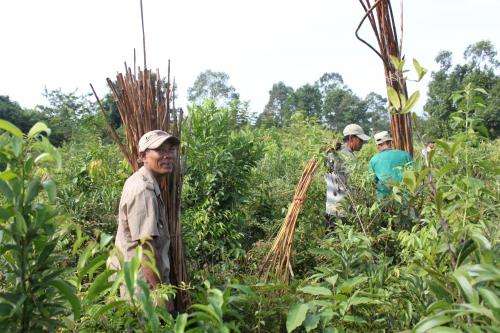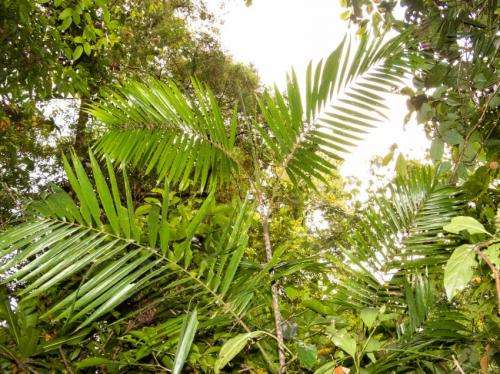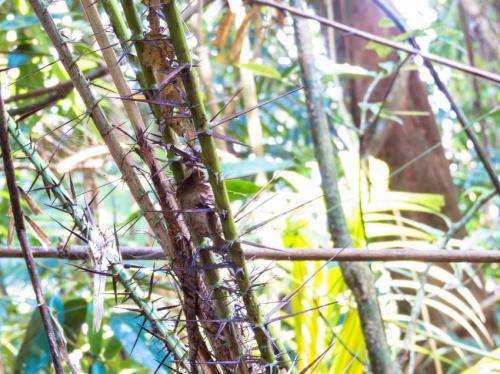In Cambodia, Laos, and Vietnam, 100 communities are engaged in sustainable rattan production. In Cambodia alone, 11 communities made up of 5,400 households are involved in the rattan production chain, from harvest to market. Credit: Copyright Eng Mengey/WWF-Cambodia
In a major advance for the sustainable use of a critical natural resource, The New York Botanical Garden and the World Wildlife Fund (WWF) today released the most comprehensive catalogue of the rattan species found in three Southeast Asian countries, including data that makes it possible to determine how much rattan can be harvested without depleting natural stocks of these versatile, economically important plants.
Systematics, Ecology and Management of Rattans in Cambodia, Laos, and Vietnam—The Biological Bases of Sustainable Use includes information on the 65 known rattan species that grow in the three countries, including two species found only in Cambodia that are new to science. The book is the result of eight years of research by Botanical Garden scientists and WWF experts.
"This book represents the most comprehensive analysis of rattans ever compiled anywhere in the world," said co-author Dr. Charles M. Peters, Kate E. Tode Curator of Botany at the Botanical Garden and a leading authority on the management of tropical forests. "It is unique in that this single volume addresses the ecological, taxonomic, and silvicultural aspects of a valuable forest resource. Most importantly, we want people to understand that you can't sustainably harvest more than the annual growth of rattan from a forest in one year."
Joining Dr. Peters as co-author is Andrew J. Henderson, Ph.D., Abess Curator of Palms at the Garden and a leading authority on the systematics, taxonomy and biology of palms, which include rattans. As part of his field research on this project, he discovered and named the two Cambodian rattan species new to science, Calamus mellitus (common name in Khmer: Pdao Toek Khmom) and Calamus kampucheaensis (common name in Khmer: Pdao Bonla Dong Penh).
This rattan species, endemic to Cambodia, is one of two species new to science that was documented and described by Dr. Andrew Henderson of The New York Botanical Garden as part of the collaborative sustainable rattan project involving the Botanical Garden and the World Wildlife Fund. Credit: Copyright Koulang Chey/WWF-Cambodia
Rattan is one of the most important non-timber forest products in the Greater Mekong region. Various species support local livelihoods as sources of food, material for shelter, and products with export value such as rattan furniture. However, forest conversion and unsustainable harvesting are leading to serious declines in rattan stocks, threatening the potential growth and sustainability of the region's rattan industry.
The book, which is available in English, Khmer, Vietnamese and Lao language versions, aims to help both naturalists and those in the rattan industry in identifying rattan species, while providing guidance in maximizing yields and achieving sustainable production of rattan resources. It also details lessons learned in numerous aspects of the rattan industry, from sustainable management planning to processing and export policies.
"We are delighted to launch this book, which clearly demonstrates that sustainable rattan management, production and trade is the only way to ensure the Mekong rattan industry will continue and thrive into the future," said Chhith Sam Ath, WWF-Cambodia's Country Director. "We urge Greater Mekong governments to use this resource as they urgently develop and implement rattan management plans."
To ensure rattan harvesting and processing do not endanger rattan and forest resources but instead offer new sources of long-term income for rural people, WWF has embarked on an ambitious project with communities and companies in Cambodia, Laos, and Vietnam. The end goal is to help improve management of rattan in the Greater Mekong region.
This second rattan species, also new to science and also described by the Garden's Dr. Andrew Henderson, is found at high elevations in the Cardamom Mountains of Cambodia. Its spines are sharper than other rattan species. Credit: Copyright Koulang Chey/WWF-Cambodia
Chhith noted that local communities in Siem Reap and the Tonle Sap region are using a rattan species found only in Cambodia (Calamus salicifolius, known in Khmer as Lpeak) to produce high-quality baskets and handicrafts that are exported to Thailand and other international markets. "This unique species is only found in Cambodia and is therefore critical to our country's biodiversity and the future of our rattan industry," Chhith said.
The book is the result of a collaboration between The New York Botanical Garden and WWF-Greater Mekong, together with relevant government and development partners. In Laos, this collaboration has resulted in the world's first rattan products to be certified as sustainably harvested by the Forest Stewardship Council (FSC). It has also facilitated the establishment of the Rattan Association of Cambodia and the Vietnam Rattan Programme—important mechanisms for ensuring that producers also secure benefits from the growing demand for sustainable rattan products.
"With support from WWF, I am engaged in rattan forest management, harvesting and selling FSC-certified rattan at a high price," said Jai Singsombath, head of the weaving group in Thaveng Village in Bolikhamxay province, Laos. "More importantly, I am, together with other villagers, engaged in processing and weaving to improve our lives, with an average income of $150 per month during the production period."
Provided by The New York Botanical Garden
























